


 |
November 22, 2014: A Museum Tour of Lima |
 |
November 20, 2014: Cuzco to Lima |
 |
Return to the Index for Our Stay in Lima |
Today, we are going to spend the entire day wandering around the historic area of central Lima. We have a guidebook, but we plan to basically just walk around from site to site and take in as much as we can.
|
We spent most of the day, and took most of our pictures, in the central area itself where we covered the distance between the central transportation hub and the Congress Building and back.
Continuing the retentive attitude that I have taken throughout this photo album, I'll try to show you more precisely the route we took, and mark on those maps the major sights we saw. It may not matter much to you what our actual route was, but if you never plan on getting to Lima, knowing what that route was, and following us as we move along it, might be a small substitute for not visiting the city yourself.
In any event, I'll be supplying more detailed maps covering the individual sections of our travels today, beginning with our walk from the apartment up to the rapid transit station on the expressway nearby.
Getting Into Central Lima
|
We were walking along the long, thin extension of Carossio Park, which you may recall is the park that is located in the ravine between Balta Avenue and the next street to the south. It's the park that slopes from a few blocks north of our building all the way down to the beach. We walked along to the top of that park, taking a few pictures as we went- including some of the park, a view looking back down Balta towards the ocean, and a British consular building. There are clickable thumbnails below for some of these pictures:
 |
From the top of that park, we continued along the upscale Avenue Balta until its name changed to Diagonal, a street which continues for a few more blocks northeast towards Avenue Jose Pardo.
|

|
One interesting thing was that as we were walking along Avenue Diagonal, I spotted an orange tabby cat sleeping peacefully right on a sidewalk grate, with lots of people walking by continuously. The cat seemed oblivious to all the activity. I had no idea why the animal had chosen such an out-in-the-open spot for its nap, but we were to discover later why the cat was here in the first place.
|
Ricardo Palma was born into a mixed-race country family that had moved into Lima. He had a Jesuit school education, and a bit of college before leaving voluntary to spend six years in the Peruvian navy. He dabbled in liberal Peruvian politics, exiled for a time Chile for allegedly participating in a failed plot against President Ramón Castilla. Returning in 1862, he again became involved in public service until 1876.
The war between Chile and Peru (1879–1883) caused the destruction of the National Library of Peru; after the war ended, Palma was named director of that library, a post he held until his retirement in 1912. Palma brought the National Library back from the ashes, recovering thousands of volumes that had been taken to Chile, and his efforts made the library one of the top libraries in South America.
Palma was a poet (his first book of verse appeared in 1855) and an historian. He was also a political satirist as well as a foreign newspaper correspondent. Palma's literary reputation rests upon his creation and development of the literary genre known as tradiciones, short stories that mix history and fiction, written both to amuse and educate, according to the author's declared intention. It was by creatively using poetic license and by deviating from "pure" history that Palma gained his large South American readership. His Tradiciones peruanas span several centuries, with an emphasis on earlier colonial and republican times in Peru.
Although it was overcast this morning, the temperature was good and the walk was a pleasant one up to Avenue Juan Pardo and then a few blocks east to the expressway. Along Juan Pardo, we passed one of many small casinos in the city (we passed a number of them yesterday on our ride in from the airport). All of them are garish and colorful, and I suspect there is more going on inside than just gambling.
|

|
Rapid transit in Lima is done a bit differently than most places; the only thing similar was the way it was done in Cuzco. On major streets or expressways, there are dedicated bus lanes right in the middle (where we might put light rail). You board the busses on platforms just like rail platforms. The system seems to work quite well and doesn't involve a huge technology infrastructure, and uses just normal busses.
After riding it three or four times during our visit, I think we all agreed that sometimes low technology is the best solution. So come along as we use this system to get into central Lima. It wasn't difficult, once we found someone to help us figure out the ticket machine. Then we went down the stairs and out onto the platform. Here is a view looking back at the entry. While much of the platform is open, the point where you actually board the busses is covered and glass-walled. The busses stop at a designated point, and when they do, glass doors on both the platform and on the bus open simultaneously- just like you may have see at airports that have tram systems. You can see us here waiting to board our bus.
Once on board, the bus made only four or five stops on the way into central Lima. The bus had one of those little route maps you've seen on subways and trains and all the stops are clearly labeled. When our bus reached the Central Station, most folks got off, for this is the main transfer point. When we got off, we went through some turnstiles (like the ones you can see here) and found ourselves in a huge, mostly empty concourse underground. There were stores and some restaurants lining the concourse, and I imagine the place is busy at rush hour. We just walked to the north end to find the stairs and escalators up to street level. As we ascended, we discovered that the station actually has multiple levels for the buses to use.
From Central Station to Plaza San Martin
|
 |
Roosevelt House was designed by Polish architect Ricardo de Jaxa Malachowski and constructed between 1919 and 1924 during a city-wide construction boom. It is an example of the French Colonial style, with arcades and padded details, guirnaldinas and medallions on the facade. It was commissioned by the RIMAC Insurance Company, but for residences- not offices. It was one of the first apartment buildings built in Lima. Otis Elevator installed Lima's first "lifts" here; the building was restored in 2007 and is and is now owned by the Metropolitan Municipality of Lima.
|
|
Just before we reached Plaza San Martin, I stopped to take a picture of Fred looking back down Carabaya Street, and you can again see the tall Centro Civico building in that picture here. And below are a few thumbnails for some other pictures that we took along Carabaya, including a shopping cart repurposed for use by a fruit vendor:
 |
A few blocks up Carabaya, we came to one of Lima's oldest city squares- Plaza San Martin. The Plaza San Martín is one of the most representative public spaces of the city of Lima. It is located within the Historic Center of Lima which was declared a World Heritage Site in 1988 by UNESCO. Its central monument gives homage to Peru's liberator, José de San Martín. As we came into the plaza from Carabaya Street, I took a series of four pictures and stitched them together into this panoramic view of Plaza San Martin:
 |
The San Juan de Dios hospital was on this site originally, but it was torn down in 1850 and replaced by a railway station, which in turn was torn down between 1911 and 1918. The Plaza San Martín as we see it today was completed in 1921 in celebration of the 100th anniversary of the independence of Peru. The benches and handrails were constructed out of marble and the paving, of granite. There were also four water fountains, bronze streetlamps, and flower-filled gardens. The design for the monument to José de San Martín was chosen in an contest in which the design created by the Spanish sculptor Mariano Benlliure emerged victorious and illustrated San Martin during his voyage across the Andes.
|
The construction of the buildings that surrounded the plaza occurred at a gradual pace. The Colón Theater and the Giacoletti buildings were the first structures to be built and were erected in 1914 before the construction of the plaza. The other buildings were later built in three stages. The Hotel Bolivar was built in 1924 and the Zela and Pumacahua arcades in 1926. The Club Nacional was built in 1929 and the remainder of the buildings between 1935-1945. All were built in the Neocolonial style (similar to Spanish Colonial Revival); one of the best examples is Edificio Fenix.
Like many of Lima's public squares, Plaza San Martin maintains uniformity with respect to its buildings' facades; it also, again like many of Lima's squares, has extensive plantings. Have a look at some of the other pictures we took in and around Plaza San Martin by clicking on the thumbnail images below:

|
We continued north along Carabaya, leaving Plaza San Martin from its northeast corner. Stopping there for a moment, I looked back and let my camera take another panoramic view of the plaza:
 |
As it turned out, we returned to Plaza San Martin tomorrow, and the weather was a bit better then. For now, though, we continued up Carabaya, just looking at the buildings and the character of Lima as we went.
|
When we crossed Avenue Emancipacion, we saw it had one of the extensions of the bus system, and you can see in the picture I took as we crossed the avenue how the lanes are allocated to them. It was a system similar to that in Quito.
Anyway, you can use the thumbnails below to see some of the interesting pictures as we walked north along Carabaya:

|
Next, we came to one of Lima's main public squares.
Plaza Mayor (Plaza de Armas de Lima)
|
If you look at the aerial view at right, you can see where we entered the square. Greg was interested in getting something to eat (it was mid-morning), so we went into the building at the south of the square, right around to our left, and found it to be kind of like an indoor mall with offices as well, and we saw a sign for a coffee shop up on the fourth floor- supposedly with a balcony overlooking the square. So we thought that might be a good way to look around before going down into the square itself, so we went inside and headed up.
There were some interesting stairs, but we decided to take a glass elevator up. The little restaurant had just opened, so we had our choice of outside tables. We did get a table out on the balcony so while we had coffee and danish we could look out across the square. We had our waiter take a picture of the four of us. And here are thumnails for just a few of the many pictures we took on and from the balcony:
 |
As we expected, and as it turned out, the balcony was a great place to view the entire Plaza de Armas de Lima, and see all of the important buildings that surround it. As it turned out, we were in the only building that wasn't either some kind of civic building or notable in some other way, although its architecture blended with that of the other edifices bordering on the square.
|
We also zeroed in on some of the other buildings you can see in the large image at right. In that image, the leftmost building is the headquarters of The Club de la Unión- a non-profit Peruvian civil association founded in 1868. The building was inaugurated in 1942 and is considered a Monument of National Heritage by the National Institute of Culture. The club supports all kinds of civic events and ventures, and has a large sports complex near the beach.
Right next to it, at the west corner of De La Union and Junin Streets, is the Municipal Palace of Lima. This building, completed in 1944, is the headquarters of the Metropolitan Municipality of Lima.
On the far side of the plaza is the Government Palace of Peru. The first building to occupy this site was known as House of Pizarro- the headquarters of the Peruvian government, built by Francisco Pizarro, the Governor of New Castile, in 1535. It was built on top of a huge Indian burying ground. It has undergone many transformations over the years. The current structure was completed in 1938 by President Oscar R. Benavides.
|
We ended up touring the Cathedral a bit later, so for now we'll just talk about the outside, which we could see quite well from the balcony. In keeping with the majority of cathedrals the front facade has three large doorways. The main or central gateway is called the Portada del Perdón or the "door of forgiveness". Above the doorway is the Peruvian seal inset into a beautiful and ornate facade. The two high towers (one of which you can see here) have spires of slate and are neoclassical with stylistic influences of the school "El Escorial" and of northern Europe.
Attached to the Cathedral on its northern side is The Archbishop's Palace- the residence of the Archbishop of Lima and the administrative headquarters of the Roman Catholic Archdiocese of Lima. The Palace is also the headquarters of the cardinal of Peru; currently, the Archbishop and Cardinal are the same person- Juan Luis Cipriani. We will get closer to the Archbishop's palace after our tour of the Cathedral, so we will have more to say about it then.
Coming up here to this balcony restaurant was a great idea, mostly because the views of Plaza Major from here were just tremendous. Fred took some additional pictures of various aspects of the square, and I want to include some of them here. You can click on the thumbnails below to have a look:
 |
And I made one more panoramic view of the entire square from our vantage point here on the balcony:
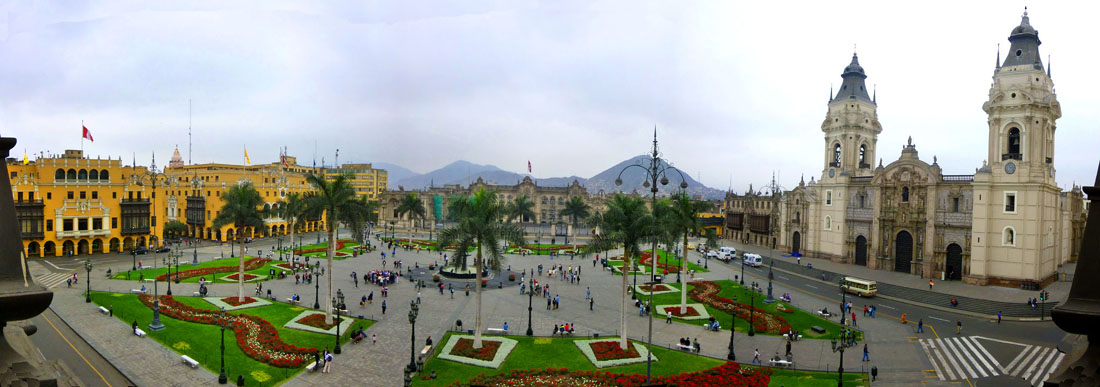 Plaza de Armas de Lima |
Fred did a panorama, too, and I think it is interesting because he included the balcony we were on as well as the square beyond:
 |
We finally left the balcony restaurant, and instead of taking the elevator, took the stairs down to the ground floor. This Plaza exists because, in 1523, King Charles I of Spain promulgated plans for New World cities; growth should follow a grid centered on a plaza in the shape of a square. It was Francisco Pizarro who determined the location of Plaza de Armas de Lima (and who, with the city's first mayor, laid out land parcels and granted them to the Church, the City and his conquistadors.
The first water fountain built on the plaza was constructed by the viceroy Francisco de Toledo in 1578. This fountain was replaced in 1651 by the viceroy García Sarmiento de Sotomayor; that fountain is today the centerpiece of the plaza to this day. Fred took another good picture of this fountain, with the Municipal Palace and the Plaza of the Flag in the background; you can see that picture here.
Before we walked over to tour the Cathedral, I made a panoramic picture of the Plaza from ground level:
 |
Sadly, activities in the Plaza have not always been all fun and games. While during the colonial era the plaza served as a market and also sported a bull-fighting ring, it was also the location of the city gallows. The plaza also became home to the activities of the Auto de fe during the Inquisition. The first "heretic" to be tried and executed in the New World was executed here in 1573.
The Cathedral of Lima/Archbishop's Palace
|
This third Cathedral was completed and the first Mass held in 1622; the Cathedral was not consecrated until 1625. A new main portal was designed and build; this is the first part of the Cathedral that still exists today. Through the 1600s and 1700s, Lima's frequent earthquakes destroyed major parts of the structure; these were continually redesigned and rebuilt. Between 1794 and 1797, the two current towers were built. For a century little was done, and in 1893 the Cathedral had to be closed because it was in disrepair and in dire need of restoration.
The most recent major rebuilding began in 1896 and took three years, with the Cathedral as we see it today inaugurated in 1898. For the last century, the Cathedral has been kept up through continued maintenance and repair. Lima still has earthquakes, but because the redesigns have prepared for them, these have not caused nearly the damage they did previously.
An Orientation to the Cathedral of Lima
|
The Cathedral has portals on all four sides. The three major entrances are on the west side, accessed via Plaza Mayor. There is a portal on the south side leading to Calle de Judíos, and there is a portal leading to a garden on the north side and, through there, to the Archbishop's Palace. At the rear are two more entrances: Santa Apolonia and San Cristóbal. Set on the front facade are sculptures of the Apostles and in the middle, the Sacred Heart of Jesus.
The original Sacristy and Chapterhouse were located in a building attached to the northeast corner of the Cathedral. The functions carried out there are now performed elsewhere in the complex, and so this area was repurposed for use as kind of a museum for the Church. Many of the Church's paintings and objects of art are kept here, and two donors created additional rooms to hold collections donated to the church. There is even one room devoted to portraits of all of Lima's Archbishops as well as visits the Popes have made to the Cathedral.
Of course we wanted to tour the inside of the Cathedral, so we bought entry tickets and went inside. It might have been better for my usual efforts to document such visits precisely if we had followed a set route through the Cathedral, but we did not. It has taken no little bit of effort to sort the pictures that Fred and I took into some semblance of order, and we will take a look at the various chapels, crypts, and of course the central nave and side aisles in turn. After we finish with the Church itself, we will have a look at the various rooms that comprise the museum.
So you can orient yourself inside the Cathedral, I've taken a diagram from one of our brochures and modified it, numbering the various chapels, rooms and points of interest. I'll refer to those numbers as we tour the Church.
We came in the right-hand of the three doors on the plaza side of the church, paid our entry and found ourselves in front of the tomb of Francisco Pizarro.
The Tomb of Francisco Pizarro (1)
|
Pizarro founded the city of Lima in 1535, but was killed by one of his own after a disagreement. Not really beloved by Peruvians, Pizarro was in it for the gold; he never found it, but did manage to destroy a great indigenous culture, language, and religion. In a move to protect and elevate his stature, Pizarro was laid to rest in this Cathedral, and is now in the first chapel on the right as you enter the Cathedral.
The whole room is an elaborate, golden encrusted mosaic of the Coat of Arms of Lima along with many other embellishments.
The sarcophagus was discovered in the early twentieth century. Pizarro's body was actually not in the grand lion topped encasement, but secretly hidden elsewhere; it was found in 1977 was found and placed in the windowed sarcophagus for public viewing. A small chest sits on a shelf at the side of the chapel; it contains earth from Pizarro's native city- Trujillo, Spain.
|
|
On one wall there was a painting of a conquistador presumably banishing Incans. You can use the thumbnails below to see views of that painting and some other views from this chapel:
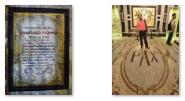
|
Right-hand Side Chapels in the Cathedral of Lima
The Chapel of St. John the Baptist (2)
|
The altarpiece depicts the saint's life and features one of the oldest and largest crucifixes in the cathedral. Considered among the best cathedral church altarpieces in the world, it was carved by the renowned artist Juan Martinez Montanes (1568-1649). Montanes was one of the very greatest and most imitated of the Spanish sculptors, known most for his realistic wooden sculptures often gessoed, polychromed and gilded (coated with a white base paint and then colorfully painted and encrusted with gold highlights). His St. John the Baptist altarpiece is prized as one of the world's greatest and it is easy to understand why he is called "The God of Wood" (el Dios de la Madera).
This altarpiece was originally in the ancient Monastery of the Conception (Monasterio de la Concepción) in Spain; it was brought to the New World and placed in the Church of the Immaculate Conception in Lima. Of course now the chapel is here, fully restored and reopened in 2012. Here is another view of the beautiful woodcarving just below the crucifix.
|
Our Lady of Candelaria Chapel (3)
In the chapel of the Virgin of Candelaria we find an altarpiece that is a masterful work of the master priest and artist Matías Maestro Alegría. It was created in 1796 and done in baroque-neoclassical transitional style. Alegria was a Spanish priest, architect, painter, musician, sculptor, and writer (1766-1835) who was especially instrumental in Lima after the earthquake of 1746, designing among other things, the two towers outside the Cathedral of Lima as well as this altarpiece.
|
St John the Evangelist Chapel (6)
Formerly named the Santa Ana Chapel and still home to the tomb of Nicolás de Ribera, first mayor of Lima this chapel has another baroque-neoclassical style altarpiece, this one of Christ Auxilio (Cristo del Auxilio) considered one of the most beautiful in this church. Ribera (1487-1563) was a Spanish, Andalusian conquistador, first Mayor of Lima. He later became the Viceroy of Peru and was given the nickname “El Viejo” (The Old One) due to his long presence in Lima, where he resided for nearly thirty years.
|
|
The Visitation Chapel (7)
This chapel has recently undergone a difficult, full restoration, and only recently became available again for full public viewing. The Chapel of the Visitation dates from the late eighteenth century, and showcases the neoclassical, aesthetic style prevailing in those years. This alterpiece was carved by the renowned artist Matías Maestro Alegría, who also created the altarpiece in the Chapel of St. John the Evangelist. Unlike most other shrines made according to the criteria of the Baroque period, the main altarpiece of this chapel is austere with neat lines and a somber colored marbling. On the left is a Risen Christ coming out in triumphal procession on Easter Sunday.
|
St. Joseph Chapel (9)
The last chapel on the right side of the nave is dedicated to San José, with an altarpiece of polychrome reliefs depicting his life. The altarpiece was originally in the Monastery of the Conception. Also exhibited in this area were reliefs of the life of the Virgin. "Polychrome (relief)" is the art of painting and decorating walls, statues and bas-reliefs in a very ornamental and colorful fashion. This technique was often practiced by Spanish artists on statues during the Baroque and Rococo periods.
|
The Cathedral of Lima: Nave and Aisles
|
The Chapel of St. Bartolomew (22)
There are a number of features of the central nave and aisles that we saw, and since we are already at the back of the church, we should take a look at the one chapel that is "behind" the main altar. This is the Chapel of St. Bartholomew. The dominating feature of this chapel is a main altarpiece of the Tuscan order; it consists of three panels depicting a major part of the martyrdom of St. Bartholomew (see the picture at left). This chapel also contains the altar and tomb of the Archbishop of Lima, Bartolomé Lobo Guerrero, which are situated off to the side. There was also a sculpture of the Archbishop in this chapel, but it is now housed in the museum.
|
There is a hall back here that crosses to the other side of the Cathedral, but for now, let's move forward to the front of the Cathedral again so that we can see the nave as visitors would see it when they first enter. We will just walk back along the right-hand aisle, past the chapels we have already seen, and back to the front of the Cathedral the front of the Cathedral near the tomb of Francisco Pizarro (right next to a model of the Cathedral. This will give us a view of the nave (24) and the main altar, which shares a name with one of the chapels we have yet to see- Our Lady of Hope. (23)
|
 |
I thought the ceiling was particularly striking, both in the nave itself and also in each of the aisles.
We walked forward to the middle of the nave, just below the steps leading up to the altar. There, we had a good view all around the Cathedral, but particularly forward to the Presbetery, the impressive choir stalls, and the altar.
|
On the back of the chair (which is located on the left under the canopy) is the figure of the Redeemer.
The altarpiece of the Immaculate is in the neoclassical style. The crypts are beneath us, and we will visit them shortly. The neoclassical pulpit is topped with a statue of St. John the Evangelist, and a crucifix to the left, from the Paschal Lamb. In the nave are four statues, two on each side, St. John the Evangelist, St. Peter St. Paul and St. James- all the work of the priest Matías Maestro Alegría.
Before we go down into the crypts, you can see another view of the Alterpiece of the Immaculate here and one more view of the Presbytery here.
The Crypts
The Archbishop's Crypt (9)
|
This burial place was used to inter the mortal remains of archbishops, viceroys, canons and other illustrious individuals. In spite of its closure in 1808, when Lima's General Cemetery was opened, burials within the crypt continued, probably of a clandestine nature. In 1977, during restoration work, the authentic remains were discovered of the founder of the city of Lima, Francisco Pizarro. Today, only archbishops have the right to be buried in the crypt.
There are thumbnails below for two more views inside the Archbishop's Crypt:
 |
The Crypt of Our Lady of the Assumption
|
The first archaeological work was carried out in 2003. So that it could be included in the visitors' circuit, complementary physical anthropology studies were carried out in 2010. It was discovered that a multi-ethnic group was buried in the crypt, including Creole and mixed-race individuals, and one person of African descent. Restoration work began in 2011 and the crypt was opened to the public in 2010. It would have continued to be used during the 17th and 18th centuries.
There are thumbnails below for two more views inside the Crypt of Our Lady of the Assumption:
 |
The Crypt of Our Lady of Candelaria
|
The dead were given Christian burials and covered with shrouds or the habits of the saints they venerated. This crypt would have been used furing the 17th and 18th centuries.
The public was allowed into the crypt for the first time in 2013.
There are thumbnails below for two more views inside the Crypt of Our Lady of Candelaria:
 |
Left-hand Aisle and Chapels in the Cathedral of Lima
|
We took a number of pictures of some of the statuary, and Fred also took some interesting shots of the interior architecture of the Cathedral. You can use the clickable thumbnails below to have a look at some of these:

|
There were seven more chapels on this side of the Cathedral, so let's have a look at them:
|
Saint Apolonis Chapel (10)
Chapel Santa Apolonia is used for storage and currently contains a small altarpiece of Saint Apolonia.
|
Chapel of Our Lady of Peace (11)
This chapel contains an altarpiece from the hospital of St. John of God. On the left wall is a painting of St. John the Evangelist, patron of the Cathedral, giving Communion to the Blessed Virgin and on the right is the tomb of the Servant of God Father Francisco Camacho.
|
|
Immaculate Conception Chapel (12)
Dedicated to Our Lady of Evangelization, this chapel has the only preserved Baroque altarpiece since the remodeling of 1896. It was so beautiful that Matías Maestro Alegría, who redesigned or replaced all of the other Baroque altarpieces with neoclassical altars, left this altar alone. Featured on the altar is the image of Our Lady of Evangelization, a woodcarving from the sixteenth century sent by the Emperor Charles V, one of the first images of the Virgin to reach the New World. In the altarpiece are Nativity figures which were the first of the city of Lima, commissioned by the daughter of Francisco Pizarro. The walls have beautiful tiles, recently restored. On the left wall of the chapel is a large painting of St. Josemaria Escriva, founder of Opus Dei, made in 2005 for the 30th anniversary of his death.
|
Chapel of Saint Rose (12)
This chapel is dominated by the image of Santa Rosa de Lima, the first saint of the Americas, along with St. Martin de Porres, St. Juan Macias and San Francisco Solano, all Peruvian saints. Also called the Chapel of Santa Rosa it holds the newly renovated grave of Bishop Emilio Lisson, XXVII Archbishop of Lima.
|
|
Chapel of Our Lady of Antigua (14)
Formerly called the “Kings Chapel” or the “Old Chapel”, The Chapel of Our Lady of Antigua has a neoclassical style altarpiece by the Spanish priest, architect, painter, musician, sculptor, and writer Matías Maestro Alegría (1766-1835) who also designed the two towers outside the Cathedral. The altarpiece has a seated Virgen de la Antigua (mid sixteenth century), two wooden statues, St. Mark and St. Thomas Aquinas, and colorful columns.
|
Chapel of Saint Joseph (Holy Family) (15)
The Chapel of the Holy Family contains an altarpiece with ancient polychrome woodcarvings of Jesus, Mary and Joseph. On the walls there two large oval frames with images of St. Peter and St. Paul and four wooden panels that were once part of the choir stalls. There are also two beautiful statues of female figures in adoration of the Holy Family; you can see those two statues here and here.
|
|
The Chapel of Our Lady of Hope (16)
We are now back at the front of the Cathedral, in the first chapel on the left. This chapel is an old baptistery with a beautiful sculpture of Our Lady of Hope (Our Lady of Sorrows). Interestingly, this sculpture is removed from the church and paraded along the streets of Lima during Holy Week. Most Peruvian towns have traditions resembling this. Recent restoration has revealed the ancient polychrome (antigua policromía) which is the art of painting and decorating walls, statues and bas-reliefs in a very ornamental and colorful fashion, so only now are visitors able experience this chapel, and all the other side chapels as they once were.
|
That completed our tour around the Cathedral itself. Now, we all moved back along the left aisle to the area just past the Door of the Oranges to the rooms once used as the Sacristy but which are now the Cathedral Museum.
The Museum in the Cathedral of Lima
We went through all the rooms of the museum, beginning with the Ante-Sacristy, entered through an archway between the Chapel of Our Lady of Peace and the Chapel of the Immaculate Conception. We'll break our tour through the museum into a section for each of the rooms.
The Ante-sacristy (17): Paintings and Sculpture
|
 |
Throughout the museum, there were displays of artwork, sculpture and ceramics; all of it was labeled but I just couldn't see the need to document each and every piece, so our look through most of the rooms will be just that- a look at the many beautiful and interesting items that were on display. There may be some few cases where a description is called for, but these will be few.
It seems that the central focus here in the ante-sacristy was the series of twelve paintings, four on each of three walls, that depicted the Signs of the Zodiac. With the twelve paintings and the golden statuary, it made for an impressive room:
 The Ante-Sacristy in the Museum at the Lima Cathedral |
As I said, the twelve paintings seemed to each take its subject matter from a single astrological sign; that sign was used as a theme, rather than as the entire subject of the picture. I took pictures of a few of these paintings (it was tough to get good pictures of the ones high up on the walls), and you can see them below:
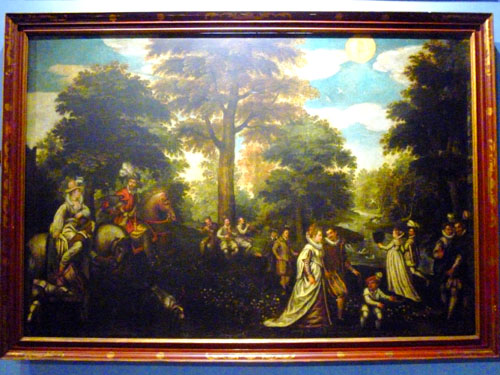 Gemini |
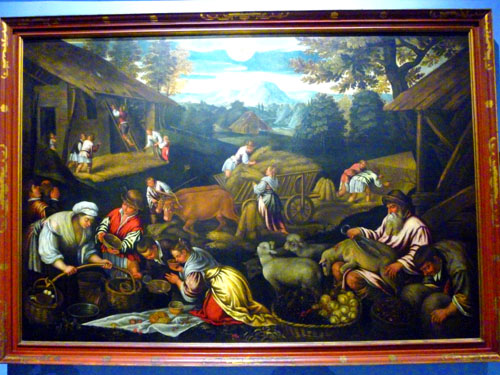 Leo |
 Libra |
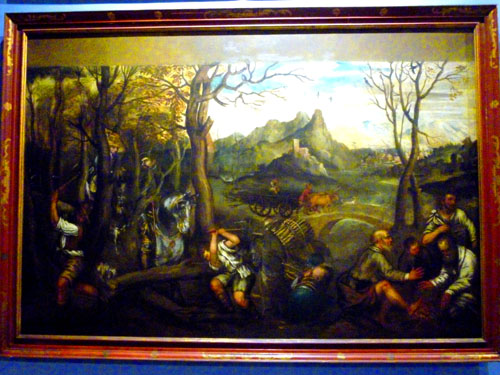 Sagittarius |
|

|
From the ante-sacristy we turned right to walk into what was once the actual sacristy.
The Sacristy (18): Paintings and Religious Objects
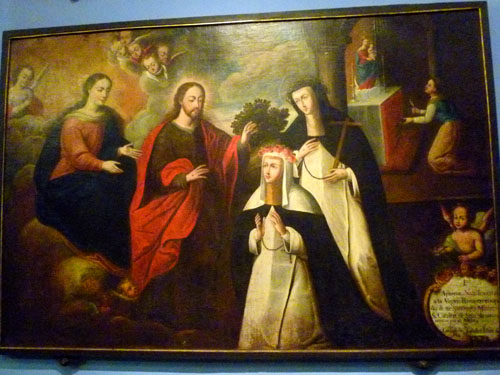 |
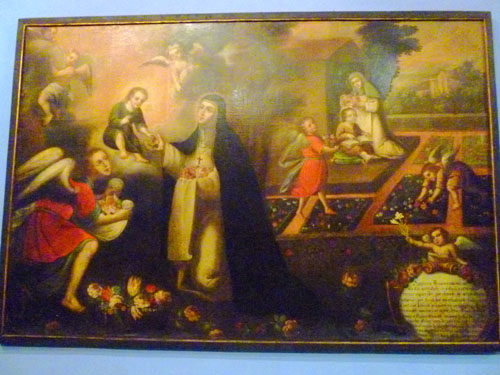 |
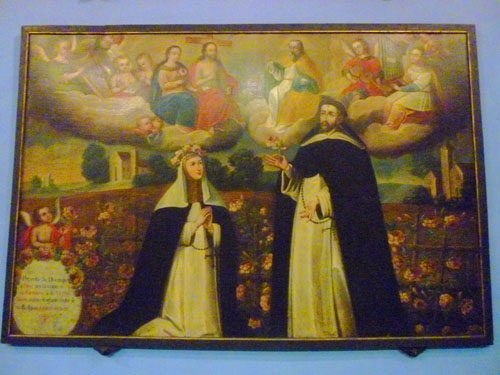 |
 |
At one side of the room was a woodcarving of San Juan Neopnucene, a national saint of Bohemia, who was drowned in the Vltava river at the behest of Wenceslaus, King of the Romans. Accounts state that he was the confessor of the queen of Bohemia and refused to divulge the secrets of the confessional. On the basis of this account, John of Nepomuk is considered the first martyr of the Seal of the Confessional, a patron against calumnies and, because of the manner of his death, a protector from floods and drowning.
In one part of the room there was a display case with religious objects, including three "monstrances." A monstrance is the vessel used in Catholic and Anglican churches for the exhibition of some object of piety. It is also used for the public display of relics of some saints. The word monstrance comes from the Latin word monstrare, "to show". Pictures of the three monstrances are below:
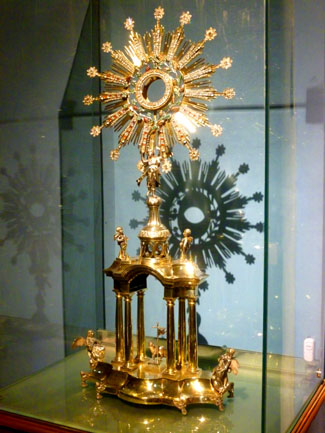 |
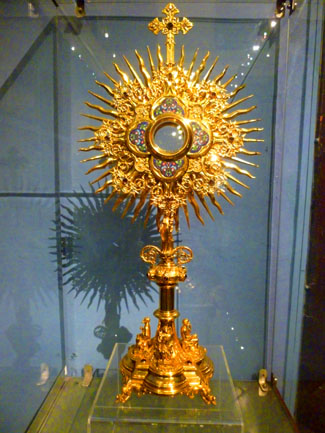 |
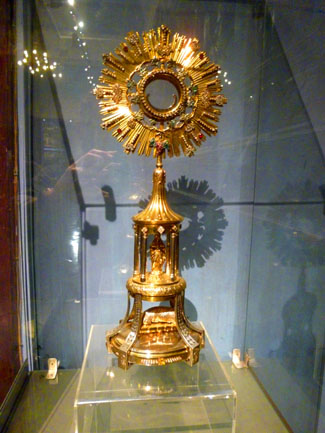 |
Just off the Sacristy is a small room, the Shroder Room (20), which displays some objects donated by Cathedral patrons, in this case Waldemar and Matilde Shroder, benefactors of the church in Lima.
To conclude our visit to the sacristy, let me include some of the pictures that Fred took of the statuary and paintings in this room. His pictures were better than mine, I think. There are clickable thumbnails below for these pictures:

|
The Chapterhouse (19): The Gallery of Archbishops
The first thing one notices on entering the room are the portraits and histories of all the Archbishops of the Cathedral through the years; each has his own large plaque. I photographed just a couple of them so you can see what they are like; brush up on your Spanish and use the scrollable images below to have a look:
In the rest of the room, there are objects relating to the Pope's visit, as well as numerous artifacts related to the elevation of one of the Lima Cathedral's Archbishops- Juan Landazuri Ricketts- to Cardinal, including the announcement letter received from the Papal Secretary in the Vatican.
|
|
In addition, we took some still pictures around the room, and you can use the clickable thumbnails below to have a look at them:
 |
The Brazzini Room (21): The Gallery of Archbishops
|
The carved figures were an eclectic mix, so it's hard to describe them. Of course there were label cards, but short of photographing all of those, there was no way to record the provenance of the various items. Here are clickable thumbnails for some of them:
 |
One common kind of figure was placed on a corner shelf, designed, I guess, for a home. Others were more intricate- some exceedingly so. Most were of painted wood, but there were some clay and ceramic figures as well. Here are thumbnails for more of the figurines that we saw:
 |
Another category of item were the carved chests. These were intricate carvings of the Nativity or other scene, usually comprised of hundreds of little figures. It looked as if they were designed to close up into a box or chest, which had to be done carefully so that the figures would not smash into each other when the chest was closed. Here are four of these carved chests:
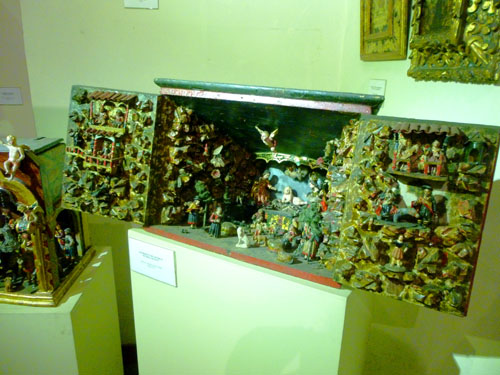 |
 |
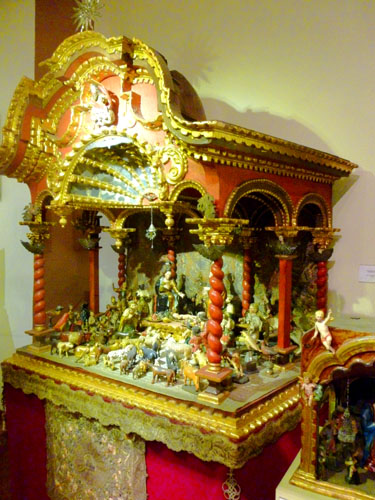 |
 |
The third kind of object we saw was the altarpiece. One of them was quite large, and probably came from a small church somewhere. The others were smaller, and may have been used in private homes. At first, I took a picture of a showcase with a collection of them, but when I looked closer, one of them caught my eye as being a particularly nice one. It was labeled as the "Altarpiece of the Virgin of Purification".
The museum, though not large, was certainly interesting, and many of the items, particularly the paintings, quite beautiful. When we were done walking through it, we went back to the front of the Cathedral. On the way, Fred snapped a picture of some interesting decoration above a door. Just outside the cathedral, we rejoined Greg and Yoost.
The Archbishop's Palace
|
Located on the land that Francisco Pizarro allocated to be the residence of the head priest of Lima after the foundation of the city in 1535, the current building was opened on December 8, 1924 and is considered a prime example of neo-colonial architectural that developed in Lima during the early twentieth century.
The old Archbishop's Palace was built on the place the Limean cabildo had occupied from 1535 to 1548, when that institution moved to its current location across the square. The building had six balconies of different styles and several entrances, displaying the Archdiocese coat of arms above the main gate. The current building was designed by the Polish Peruvian architect Ricardo de Jaxa Malachowski. Erected joined to the Cathedral of Lima, the location formerly belonged to the city's first police station and the city's first jail. After Pope Paul III designated this temple as the primary church headquarters of the city, the location became the current location of the Archdiocese.
The facade is made up of baroque elements, completely made of reintegrated rock; ornate cedar balconies are located over the main doors, and the palace is finished by a granite sculpture of Saint Turibius of Mongrovejo the patron protector of the Archdiocese.
Before we continued on our walking tour of historic Lima, both Fred and I took some additional pictures around Plaza Mayor. There are thumbnails below for five of these (and in the first one you can see beyond me the rooftop restaurant where we'd had our snack earlier):
 |
In addition, I let my camera put together another panoramic view of Plaza Mayor, and you can see it below:
 Plaza Mayor From the Steps of the Lima Cathedral |
We walked north along the side of the Archbishop's Palace, to stop at the east corner of Plaza Mayor before continuing north up the street that you can see behind us in that picture.
Walking to Lunch and Then to the Market District
|
From our corner, we could look back at Plaza Mayor, and just on the opposite corner was the eastern end of the Government Palace. The Government Palace of Peru, also known as House of Pizarro, was the house of the Peruvian government headquarters, erected in 1535, and was built over a huge Indian burying ground. It has undergone many transformations over the years. The current structure was completed in the 20th century by President Oscar R. Benavides during his second government in the 1930s.
The palace is a stately building with a set of ornamental guards. It is recognizable by the large wrought iron fence that surrounds the building and lines one side of the Main Square (Plaza Mayor). In that last picture, you can see Carabaya Street, the street we'll be taking as we walk north along the east side of the Government Palace.
|
Carabaya Street deadended at the front of a building that we could see from a block away, and which Fred photographed from back at the Archbishop's palace; you can see that photograph here. You can read "Casa de la Literatura Peruana" on the front of the building in that picture, so we assumed it would be some sort of public library or center of literary activity. But above that name was an older one- "Ferrocarril Central". I got it that the prefix "ferro-" is Latin/Romance Language for "iron" but what did "carril" mean? I learned later that the Spanish word "carril" translates to "lane". So what was an "iron lane"? Turns out that "ferrocarril" translates to "railroad"; this building used to be the central railway station, but has been repurposed.
|
Today, the former station is the House of the Peruvian Literature, a literary and cultural space where the life and work of Peruvian writers is showcased and cultural activities take place. The three-level station building was completed in 1912. Its construction was quite modern; it was one of Lima's first reinforced concrete structures.
The main distinctive features inside are the two huge stained glass ceilings. The building is divided into two sections. When you first enter the building, you are in the entry hall. This area is just at the top of the grand staircase. This staircase leads down to the lower level (which used to be where the actual platforms for the trains were located). This part of the building was three stories high, and was a bright, open room with beautiful columns.
Standing at the top of the staircase and looking up, we could see that this part of the building had a high stained glass ceiling that was quite beautiful. Fred took a close up of the center portion of this ceiling where most of the colored stained glass was, and you can see that closeup view here. Off to one side was one of the original ticket booths- an ornate wooden affair.
Going down the main stairs and passing through the columned archway, we found ourselves in what looked more like a library or resource center; there was a large desk in the middle of the room and various function rooms off to the sides. The main feature of this room, though, was its beautiful stained glass ceiling.
|
We thought this ceiling was pretty spectacular, and we took quite a few pictures of it. There are clickable thumbnails below that you can use to see some of the best:
 |
Another interesting element in this particular room was the intricate design of the tile floor. I continued on through the room, going out through a bank of doors at the far side, and I found myself on what used to be the station platform. Much of what used to be the rail station is still in place- such as the flyover to the other side of the tracks as well as the tracks themselves. (I am pretty sure no trains use these tracks anymore; the city has grown quite beyond them.)
When we came back out of the front of the building, Fred got a good picture of the upper part of the facade. You can see that one of the figures is actually holding a small train engine! Just before we left the old station to continue our walk, I took another in my Lima photo series entitled " Fred with Peruvian law enforcement". From the literary center, we turned east on Ancash Street, heading towards the Church of San Francisco. We took a few interesting pictures along the way- windows and doors and little shops, selling all manner of things from artwork to hats.
|
The church and monastery were consecrated in 1673 and completed in 1774. The church survived several major earthquakes through teh years, but suffered extensive damage in the earthquake of 1970. The church is noted for its architecture, a high example of Spanish Baroque. Its carved granite portal would later influence those on other churches; inside the architecture and painting are a mix of Moorish and Spanish designs.
The catacombs were rediscovered in 1943, and contain thousand of skulls and bones, having served as a burial-place until 1808, when the city cemetery was opened outside Lima. It is estimated that 25,000 bodies were laid to rest there; the crypts, built of bricks and mortar, are very solid and have stood up well to earthquakes, it is also believed that there existed secret passageways that connected to the Cathedral and the Tribunal of the Holy Inquisition.
The convent originally included seven cloisters (the main courtyard, St. Bonaventure, St. Francis Solanus, Pepper Yard, the Infirmary, the Novitiate and the Third Order). During the works to open Abancay Avenue in the 1940s, part of the monastery (including St. Bonaventure's courtyard) was demolished, and the section used by the Third Order was separated from the main structure. Another cloister, that once belonged to the Franciscans, was given to the Society for Public Welfare around 1847 and became part of the Ruiz Dávila Hospice. Another part of the complex is now used by the Peruvian National Police.
|
|
The restaurant was actually quite good, and the portions were pretty big; I just shared with Fred while Yoost had a steak dinner which came with some pretty good fries. We were all pretty full when we were done. Here are clickable thumbnails for some pictures that I took inside the restaurant:
 |
I found the third picture- the one cautioning patrons to keep track of their personal items- very interesting. I wondered why there were so many mistakes in the first sentence and none at all in the second.
|
|
We also took a few interesting pictures, including one of a sidewalk artist, and you can use the clickable thumbnails below to have a look at a couple more of them:
 |
After another block or so, we reached Avenue Abancay.
The Peruvian Congress and the Market District
|
When we got to Avenue Abancay, I took a picture looking to my left because I saw a mountain/hill in the distance with a cross on top.
 |
As it turns out, this was Cerro San Cristobal. Cerro San Cristobal in Spanish. The hill is part of the Rimac valley mountain range and got its name in 1535, shortly after the Spaniards erected a large cross on the hill. The site was selected because it was the closest high hill to Lima, so many people would be able to see and visit the cross. Since its construction, the cross has stood atop the hill; although damaged by native tribes over time, it has prevailed. Though we did not ascend the hill, views of the city from there are reportedly quite beautiful. Looking south on Abancay we are looking towards the southwest to the center of Lima. We crossed the street and walked south a block to the Peruvian Congress building.
|
|
I made a movie outside the front gates, and you can use the player at left to watch it. And below are thumbnails for some of the other pictures we took at the front of the Legislative Palace:
 |
Just past Plaza Bolivar, we turned east on Junin Street two buildings that housed additional Congressional offices, and then we walked past the side of the actual Congress building. As we passed down the street, we got better looks at the front and the back of the Peruvian "Capitol Hill". At the next corner, Avenue Andahuayias, we took a quick look to the left and decided to turn right to head down that street into what looked like a combination street fair, pedestrian mall and open-air market. At this point, we were right in front of the Institution Mercedes Cabello de Carbonera.
|
This building was originally the seat of Santo Tomas College of the Holy Trinity, founded in 1645 as a training center for Dominican friars. The church and convent were large, and construction took seven years, the building finished in 1670. Designed by Fray Diego Maroto, the buildings are also good examples of Baroque architecture. The architectural ensemble noted for its strength and its sumptuousness.
With the advent of the Republic, the College closed, and its buildings were used as a market, until a new, larger one was built nearby. Then the buildings served for a time as a prison for women, eventually becoming the women's college it is today. Incidentally, the altars and other religious aspects were transferred to the Church of Nuestra Señora de las Mercedes de Lima and in 1952 the buildings restored and repurposed. Much of the college still looks like a church inside (and there is still a chapel here).
Although the buildings were adequate for a college, Mercedes Cabello was included in the National Recovery Program for Public Educational Institutions begun in 2009. The historic nature of the buildings kept them in place even as the college moved to a new, more modern location elsewhere in Lima. Today, the actual college has over 2000 students in a modern physical plant. The old buildings were impressive, and as we turned in front of them we began our walk through the open-air market.
|
|
Most of the buildings we passed looked moderately old, although there was the occasional modern new building. There was a lot of colorful Christmas merchandise and lots of other interesting vendor displays. There are clickable thumbnails below for some of the pictures we took along the street:
 |
We walked two blocks through the market, and saw that it continued for quite a distance. We chose to turn back towards central Lima, and, as we did, we passed through a large Chinese gate. As we walked northwest back towards Avenue Abancay, we were walking alongside the Mercado Central, a large multi-stall market for foodstuffs and some other items.
|
|

|
On the west side of the Central Market, there were some other vendors with non-food items, like this one with pots and pans and housewares, and near him we spotted a little orange tabby cat playing with something fuzzy. The cate was cute, and I made a movie of some of his antics; you can watch him with the player below:
|
|
From the market, we walked to Avenue Abancay and then crossed it to the west.
Returning to the Paseo De Los Heroes Navales
|
This particular church was completed in 1638; it is administered by the Jesuits and it was created Basilica as part of the Archdiocese of Lima. In this church, the Sacred Heart of Jesus is venerated.
The church is part of the Historic Centre of Lima, which was added to the UNESCO World Heritage List in 1991.
The two-block walk up Avenue Ucayali was interesting; we were in an old area of the city, but many of the buildings had apparently been renovated, and there was a mix of municipal and government offices along with a few stores and such.
|
We took some more interesting pictures as we walked down the avenue towards Avenue Lampa- including the Peruvian Ministry of Foreign Affairs. There are clickable thumbnails below for some of these pictures:

|
On these side streets, and elsewhere in Lima, we saw a common kind of building construction- beginning with the Archbishop's Palace. It was the wooden balcony that seemed ubiquitous throughout this area. These balconies were intricately carved out of dark wood, each one seemingly more ornate that the last. We turned back southwest on Avenue Lampa, heading back towards the central bus station.
One interesting building that we passed was the offices of El Comercio- a Peruvian newspaper founded in 1839 that currently has a circulation of 125,000. It is the oldest newspaper in Peru and one of the oldest Spanish-language papers in the world. The government of Juan Velasco Alvarado expropriated the newspaper in the mid-1970s. The company was returned to its original owners by President Fernando Belaúnde Terry on July 28, 1980, the same day he assumed office. It was his first official act upon assuming his presidency.
|
|
To view the slideshow, just click on the image at left and I will open the slideshow in a new window. In the slideshow, you can use the little arrows in the lower corners of each image to move from one to the next, and the index numbers in the upper left of each image will tell you where you are in the series. When you are finished looking at the pictures, just close the popup window.
It was a really neat walk down Avenue Lampa back to the Central Station, but before we went down into the station itself, I wanted to go out into the middle of the park just north of the Paseo de Los Heroes Navales and take a few pictures.
The Promenade of the Naval Heroes is comprised of a long park and walkway running north to south and a square located in the center of the park's two sections. The park is between the two, one-way street portions of the Paseo de la República. Bordering the Paseo are numerous buildings, including the Palace of Justice, the Civic Center, Edificio Rimac, an Italian Art Museum, the Sheraton hotel and Plaza Grau.
The very first thing I did when I got out to the center of the Promenade was to take a series of pictures to put together into a 360° view of the entire area. It turned out well, and you can have a look at it using the scrollable window below:
As you can easily see, the entire Paseo is a very pretty space; I could only have wished that the weather had been better- particularly since the panoramic view turned out so well.
|
Below are clickable thumbnails for some of the pictures I snapped while I was out here in the middle of the Promenade:
 |
I also let my camera do one more panoramic shot, this one looking north towards central Lima, with the Rimac Building featured prominently in the center:
 |
I rejoined Fred, Greg and Yoost, and we began the trip back home to the apartment.
Cats! Cats! Cats!- A Visit to Parque Kennedy
|
|
 |
We queued up at the door we figured out was for our bus, and made the little movie that you can use the player at left to watch. I also took a couple of pictures of the underground bus lanes, and you can have a look at those here and here.
I got a good picture of Yoost on the bus as we rode back to Miraflores, and when we got there and were walking back to the apartment, I snapped a picture of the traffic circle at the top of Avenue Diagonal. Then, just as we came to the beginning of Parque Central de Miraflores (the park just north of Parque Kennedy) we found that there was a blood drive going on.
|
 |
Now, I am pretty sure that the same cat hadn't been sleeping in the same place all day long, but even so, I thought it was an odd coincidence. It was just then that we looked up, and out into Parque Kennedy and saw that the orange tabby was far from the only cat around- there were a great many of them wandering around the park. A quick count found fifty or so but there could have been more.
|
The cats were of every color you could imagine; we took lots of pictures of individual cats, and you may not care to look at very many, but here are clickable thumbnails for some of them:

|
We saw that someone had been feeding the cats; there was an area where eight or ten plates of food had been put out- some dry food but mostly canned food. We assumed that the empties were collected or refilled, as there did not seem to be a lot of empties laying about. So we got interested in the cats of Parque Kennedy. Where had they come from? Was someone taking care of them?
|
You can read the entire article if you will click on the article's summary paragraph at left. A separate window will pop up that will allow you to scroll through the article. When you are finished, you can just close that window.
And I'll leave you with some more pictures of the Cats of Parque Kennedy. Some of these pictures are puzzles where you can see how many cats you can find sitting on the grass or nestled in the flower beds. Use the clickable thumbnails below to have a look:
 |
Greg and Yoost had gone on ahead of us back to the apartment, where we would join them for a while before going to dinner at Larcomar- a ritzy shopping center near us that overlooks the Pacific.
An Evening at Larcomar
|
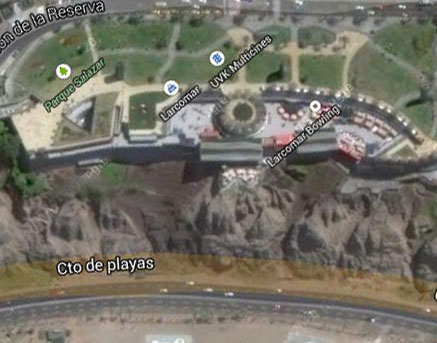 |
The Larcomar mall in Miraflores is owned by a Chilean company that has turned it into a destination; the mall is visited frequently by international tourists, as well as by locals from Miraflores and other parts of Lima. It is located on Avenida Jose Larco (the coast highway) and it is along the cliff next to the ocean ("mar" in Spanish)- thus the name Larcomar.
Before we ate, we spent some time walking around the mall, which, insofar as the stores were concerned, was pretty standard. All the large international store chains were represented, but there were South American and Peruvian chains as well. But the attraction of the Larcomar is its setting overlooking the Pacific Ocean. Even at night it was impressive. Here are clickable thumbnails for some of the pictures Fred took of the mall as we walked around:
 |
This evening, we found the Larcomar already decked out for Christmas- decorations that included a huge Christmas tree. The Larcomar has indoor and outdoor areas, and includes a cinema, bowling lanes, a food court, museum, tourist shops, eight or nine restaurants (some international chains and some Peruvian), book stores, clothing stores, and electronics stores.
|
|
I took my own pictures as we walked around before dinner, and there are clickable thumbnails below for four of them:
 |
We picked one of the local restaurants for our dinner, and we had a nice table by the window overlooking the ocean. It was nighttime, of course, so we couldn't see much, but even so we enjoyed looking out while we had dinner. When we were all done eating and took a bit more time to explore the mall, we headed back to the apartment- this time following the coast highway and crossing the lighted bridge that you've already seen pictures of.
Tomorrow, we plan to visit a couple of museums- most particularly the Museum Lorca, a museum of Peruvian culture.
You can use the links below to continue to another photo album page.
 |
November 22, 2014: The Museums of Lima |
 |
November 20, 2014: Cuzco to Lima |
 |
Return to the Index for Our Stay in Lima |